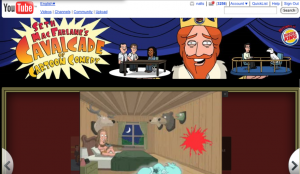When we weren’t having “my dad can beat up your dad” debates as children, we had the “Burger King versus McDonalds” debate. Of course, now I go wherever my kids tell me because they’re not going to eat a thing anyway until the meal toys are edible.
But the WillVideoForFood 2008 “Fast Food Online-Video Award” goes to… Burger King. Don’t get me wrong- the freaky masked Burger King’s appearances in TV ads gave me Wes Craven nightmares too. But at least the brand’s recent online-video campaign “Cavalcade” makes sense (and I’m not even a Family Guy addict).
Seriously- this McDonalds “The Reality House” series is a classic example of a brand’s futile attempt to develop its own content on a desert island… it’s as tired as the old lady rapping. It’s as perplexing as McDonald’s first commercial. Contrast that with Burger King’s Seth MacFarlane Cavalcade program, which was a smart use of YouTube, a visible and high-engagement promotion for Burger King, and a brilliant way to leverage a known creator while “fishing where the fish are.” The deal involved a generous check to Seth (not to mention that the deal grew his own onlie audience), a healthy InVideo and homepage BK media spend on YouTube, and brief pre-roll promotion that didn’t interfere with the entertainment- in fact it was illustrated by Seth (or more likely outsourced child cartoonists that got axed by Martha Stewart).
For the love of God, agencies, please stop trying to create custom-branded programming with names like Menuaire, or expensive microsites packed with overly-baked video content. The result is that nobody cares, and then giant media budgets must be diverted to drive traffic to easily forgotten destination sites. If you’re buying Dove banner ads to engage consumers around natural beauty, that makes some sense (as long as you don’t run ’em against uploaded Ax ads). But please don’t promote a Dove web series written by frustrated screen writers slaving helplessly under the oppresive reign of a thick-accented agency creative executive with bad breath and untreated ADHD.
I’d rather see those ad dollars getting us to eat more burgers. I’m all about engaging customers with entertainment, but do it with people that know the medium or have proven they can draw a crowd. And put the billboards on a highway rather than erecting giant signs that say, “exit here to watch a mildly entertaining advertisement.”
When P&G wanted to access stay-at-home moms, they didn’t started a new branded entertainment network scripted by brand managers that spent more time with their heads in excel sheets than facing television sets. They convinced the big networks to write soap operas, left the writes alone to hydrate the insatiable drama thirst of moms, and jammed the shows full of ads. Today’s version might have involve product integration (her tragic car accident was a result of restless knee syndrome), but the model is fairly time-tested and simple:
- Promotion takes a quiet backseat to novel entertainment or nobody engages
- The content goes where people are already hanging… it’s extremely hard to compel someone to leave YouTube for advertainment.
- Leverage people who know the medium and have proven they can draw crowds in online-video (or in Seth’s case, leverage recognizable equity from television).
Just because entry costs to content production have dropped doesn’t mean brands should become entertainers. The result is often like watching a wedding slide show with cheesy Powerpoint transitions and random dissolves. Or that flier that screams “hey- I just learned desktop publishing, and look how many fonts and clip art I squeezed onto an 8.5×11!”

